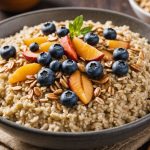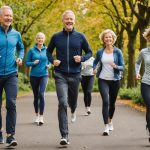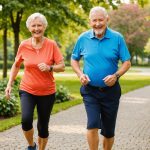Understanding Joint Health in Seniors
Joint health is pivotal for senior wellness, significantly affecting mobility and overall quality of life. As we age, joints undergo physiological changes that can lead to aging joint problems, such as stiffness and decreased range of motion.
Importance of Joint Health
Joint health is crucial for maintaining independence and reducing the risk of falls. Without proper joint function, everyday activities can become challenging or painful. Seniors often face issues like arthritis, which is characterized by inflammation and pain in the joints. Osteoarthritis, the most common form, involves the breakdown of cartilage, making movement difficult.
In parallel : Empowering Engagement: Lifelong Learning Opportunities for Seniors Aged 80 and Beyond
Common Joint Issues
Among the joint health concerns in seniors are rheumatoid arthritis, gout, and bursitis. These conditions not only restrict movement but also diminish overall senior wellness by impacting comfort and mental health.
Benefits of Exercise
Exercise is a valuable tool in preserving joint health. Low-impact activities like swimming and cycling enhance flexibility and strengthen muscles surrounding the joints, offering support and alleviating pressure. Regular physical activity also helps maintain a healthy weight, lessening the strain on aging joints and delaying the progression of joint-related issues.
Also to discover : Adapting Living Spaces for Seniors: Effective Strategies to Enhance Comfort for Those with Hearing Loss
Understanding and addressing these factors can promote a healthier, more active lifestyle for seniors.
Benefits of Gentle Exercise for Joint Health
Engaging in gentle exercises can significantly alleviate joint pain and stiffness. Activities such as swimming, yoga, and tai chi are designed to be low-impact, making them ideal for improving joint condition without causing additional strain. Incorporating these gentle activities into your routine can lead to noticeable improvements in mobility and flexibility.
Regular participation in gentle exercises enhances flexibility and increases the range of motion. This helps to maintain the joints’ functions and supports the body’s capacity to move with ease. Improved joint mobility fosters daily activities’ ease, allowing individuals to enjoy a more active lifestyle without the discomfort typically associated with joint issues.
Furthermore, gentle exercises contribute to enhanced overall well-being and mental health. Activities, especially those done in nature or group settings, provide a relaxing environment which can reduce stress, improve mood, and boost self-esteem. Mental health benefits include reduced anxiety and depression, thanks to the endorphins released during physical activity.
Incorporating gentle exercise into your life promises multiple benefits, focusing on both physical improvements and mental well-being. By consistently engaging in these activities, you support both your body’s and mind’s health, paving the way for a balanced and fulfilling quality of life.
Recommended Gentle Exercise Activities
Engaging in gentle exercises can be particularly beneficial for those seeking suitable activities to maintain an active lifestyle without overexertion. These exercises not only enhance flexibility but also bolster overall well-being.
Stretching Exercises
Stretching is vital, especially for seniors, as it enhances flexibility and joint health. Simple, regular stretching routines can help maintain mobility and reduce stiffness. Suitable activities like stretching should include slow, controlled movements, allowing muscles to warm up before more strenuous activities. To ensure safe stretching practices, it is crucial to avoid bouncing, hold each stretch gently, and breathe deeply during the exercises. This helps in maintaining a steady and enjoyable exercise routine.
Swimming as a Low-Impact Exercise
Swimming offers numerous benefits as a low-impact exercise. It significantly aids in joint pain relief due to the buoyancy of water which supports the body, reducing stress on joints. For optimal results, seniors should focus on recommended swimming techniques such as freestyle and backstroke for their gentle support and engagement of various muscle groups. Attention to safety considerations is paramount—ensure the pool environment is secure, consider using floats, and never overlook the importance of staying hydrated during sessions.
Safety Tips for Seniors Engaging in Exercise
Exercise safety is crucial for seniors to maintain health and independence while minimizing risks. Before beginning any exercise program, it’s essential to consult a healthcare professional. They can provide tailored exercise guidelines based on medical history and physical abilities. This step is vital for creating a safe and effective routine.
Preventing injuries during exercise involves several considerations. First, always start with a warm-up session to prepare the body and avoid sudden strain. Use proper exercise equipment and ensure it is well-maintained. Gradually increase intensity to give muscles time to adapt and prevent overuse injuries. Listening to your body is key; if any exercise causes pain or discomfort, it should be modified or stopped.
Choosing the right environment also promotes exercise safety. Opt for spaces with even ground and adequate lighting to minimize falls. If exercising outdoors, be mindful of weather conditions and dress appropriately. Indoors, ensure there is enough space to move freely without obstacles.
By following these injury prevention tips, seniors can enjoy the physical and mental benefits of exercise while reducing the risk of injury. Staying active is essential, but doing so safely is paramount.
Real-Life Testimonials and Expert Opinions
The impact of gentle exercise on seniors is best illustrated through personal stories and success stories. Take, for instance, the story of a retired teacher, Linda, who found her vibrant energy return after incorporating regular, gentle walks into her daily routine. Linda highlights, “My morning strolls transformed my outlook on life. It’s not just about physical health; it’s about feeling alive.”
Beyond personal anecdotes, expert advice provides invaluable insights into the efficacy of such practices. Healthcare professionals consistently advocate for low-impact exercises, such as yoga or stretching. Dr. John Smith, a leading geriatric specialist, emphasizes, “The key is consistency. Even modest physical activity can significantly improve mood, balance, and overall well-being.”
Moreover, seniors are often encouraged to initiate gentle exercise programs, even if starting seems daunting. The message is clear: it’s never too late to invest in one’s health. Numerous support groups and community programs are available, designed to foster an environment of encouragement and shared success. By engaging with these resources, seniors not only gain physical benefits but also build social connections that enhance emotional health and motivation.











